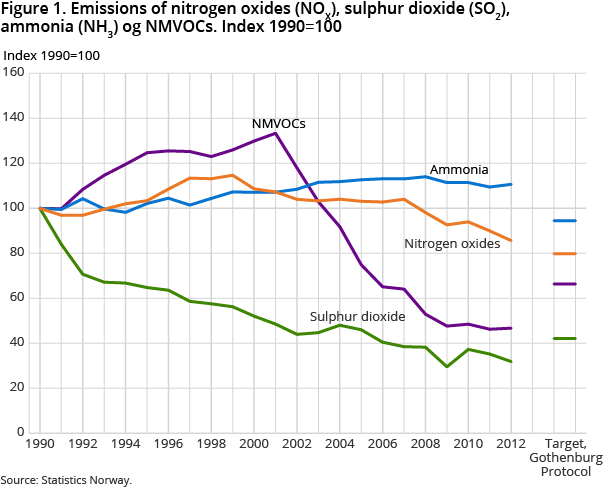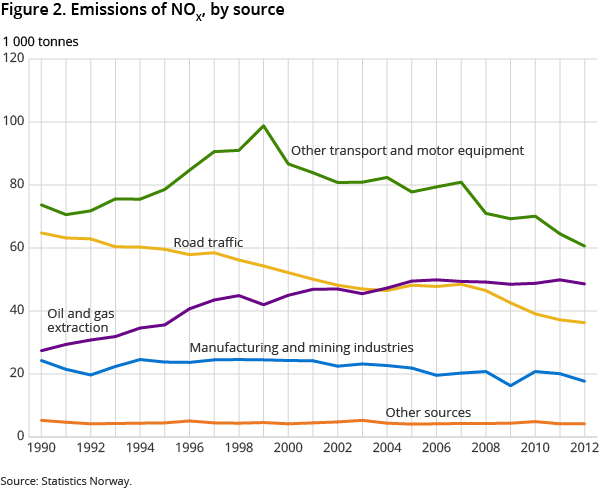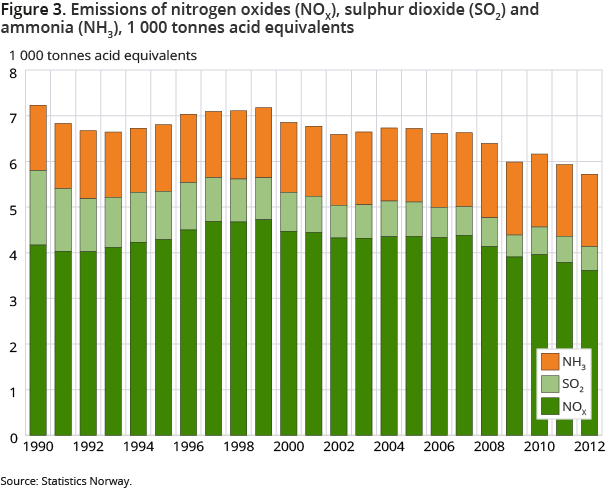Content
Published:
This is an archived release.
Closer to NOx emissions target
The emissions of nitrogen oxides fell by 5 per cent in 2012, continuing the previous year’s decrease. If the downward trend proceeds, Norway will meet its international obligations this year.
| 2012 | Change in per cent | ||
|---|---|---|---|
| Since 1990 | 2011 - 2012 | ||
| 1Does not include international sea and air traffic. | |||
| Nitrogen oxides (NOX) | 166 | -13.3 | -4.6 |
| Sulphur dioxide (SO2) | 17 | -68.1 | -9.5 |
| Ammonia (NH3) | 27 | 10.7 | 1.1 |
| Non-methane volatile organic compounds (NMVOC) | 137 | -53.2 | 1.0 |
| Carbon monoxide (CO) | 301 | -59.8 | -2.8 |



The figures result from new, updated estimations for 2012, with a detailed distribution by source and industry of the emissions of nitrogen oxides (NO X ), sulphur dioxide (SO 2 ), ammonia (NH 3 ), non-methane volatile organic carbon (NMVOC) and carbon monoxide (CO). The new estimations mainly confirm previous trends , but the sulphur emission is revised slightly downwards.
Emissions of nitrogen oxides approaching the target
Norway emitted 166 000 tonnes of nitrogen oxides (NO X ) in 2012, after a 4 per cent annual drop on average since 2007. The decline mainly occurred within transport and special purpose vehicles, but a substantial decline was also seen in the emissions from manufacturing and mining in 2012. The establishment of industries’ fund for financing efforts to reduce NO X (the NO X Fund) and cleaner motor technology have in particular contributed to these reductions.
According to the Gothenburg protocol , the Norwegian emissions shall not exceed 156 000 tonnes per year by 2010, though with a slightly different delimitation of Norwegian emissions. These emissions totalled 164 000 tonnes in 2012; 5 per cent higher than the Norwegian obligation. If the downward emission trend continues, Norway will meet its obligations this year.
A revision of the emission factor for diesel engines on offshore installations has caused a 2 to 3 per cent drop in total emissions for all years. Emissions from international aviation and navigation add to the figures in Statistics Norway’s emission statistics, and are excluded from the obligations pursuant to the Gothenburg Protocol. Rough estimates indicate slightly more than 100 000 tonnes of NO X from these sources in 2012.
Further reduction in sulphur emissions from manufacturing and transport
The sulphur dioxide (SO 2 ) emissions in Norway ended at 16 700 tonnes in 2012; a drop by nearly 10 per cent since the previous year. Norway has thus reduced its sulphur emissions two years in a row, after the intermediate increase in 2010. The 2012 emission was just a third of the level in 1990. The sulphur emissions mainly stem from coal and coke consumption in metal manufacturing and combustion of heavy fuel oil, and manufacturing and mining is still the main source of emissions of SO 2 in Norway, accounting for 69 per cent of the total in 2012. The main reduction in sulphur emissions the last year was within manufacturing of metals, carbide and paper/pulp, in addition to domestic navigation. The reductions in emissions since 1990 are mainly achieved by using fossil fuels with a lower sulphur content, improved pollution control, cleaner production technologies and the closure of pollution-generating businesses.
Stable ammonia emissions
The Norwegian emissions of ammonia (NH 3 ) rose by one per cent in 2012 from the previous year. There have been just small variations in the ammonia emissions since 1990. Since the new estimation method for emissions from manure implemented last year raised the emission figures, the Norwegian ammonia emissions have exceeded the ceiling in the Gothenburg Protocol. The 2012 emissions reached 26 900 tonnes, which is 17 per cent higher than the obligation. Of this, 91 per cent was from agriculture.
More volatile organics, less carbon monoxide
A slight increase of one per cent in the non-methane volatile organic carbon (NMVOC) emissions from the previous year was seen in 2012. The long-term trend after 2001 is, however, a substantial decrease. The NMVOC emissions have declined by 65 per cent since 2001, and in 2012 ended well below the Gothenburg obligation. Emission abatements within crude oil loading are the main cause. The NMVOC emissions are distributed between most source categories, and in 2012 ‘Other sources’, which include solvent use, was the largest one comprising 35 per cent.
The emissions of carbon monoxide (CO) went down by 3 per cent in 2012, compared to the year before, and ended at 301 000 tonnes. There has been a decline almost every year since 1990, and in 2012 the emissions reached only 40 per cent of the level in 1990. Road traffic used to be the main source of carbon monoxide emissions in Norway, but today wood-firing is contributing the most. Norway has no international commitments regarding this pollutant.
The lowest acidifying emission since 1990
The total emission of the three gases NO X , SO 2 and NH 3 in 2012, measured as acid equivalents , dropped by 4 per cent from the previous year, and by 21 per cent from 1990. The sulphur emission has shown the steepest decline from 1990, but since 2007, the nitrogen emissions have also dropped markedly. In 2012, NO X comprised 63 per cent of the emissions. When the Gothenburg obligations are converted to acid equivalents, the 2012 emissions exceeded the sum of emission ceilings by 5 per cent.
Adjustments to the emission inventory in NOx from diesel engines Open and readClose
In this year’s estimations, the NOX factor for diesel engines on offshore installations was adjusted in line with the changes that were previously made for navigation. The standard factor is reduced from 70 g/kg to 54 g/kg, which corresponds to a fall of 23 per cent. The standard factor is applied to all consumption of engines on installations up to 2002. For 2003 onwards, most emissions are based on reported figures, but for the remainder, insofar as they are estimated using the standard factor, the emissions are reduced.
Norway is committed to further reductionOpen and readClose
In the EU directive 2001/81/EF (NEC), which through the EEA agreement also applies to Norway, the countries are committed to the same obligations as the Gothenburg protocol .
The delimitation of which emissions are to be counted as Norwegian, is slightly different in the Gothenburg Protocol than in Statistics Norway’s emission statistics. The difference relates to aviation, where the emission statistics cover all emissions from domestic aviation, while the Gothenburg Protocol covers landing and take-off only, but includes international flights by both Norwegian and foreign companies. The emissions tend to be slightly lower according to the Gothenburg Protocol than in Statistics Norway’s emission statistics.
The statistics is published with Emissions to air.
Contact
-
Statistics Norway's Information Centre
E-mail: informasjon@ssb.no
tel.: (+47) 21 09 46 42
